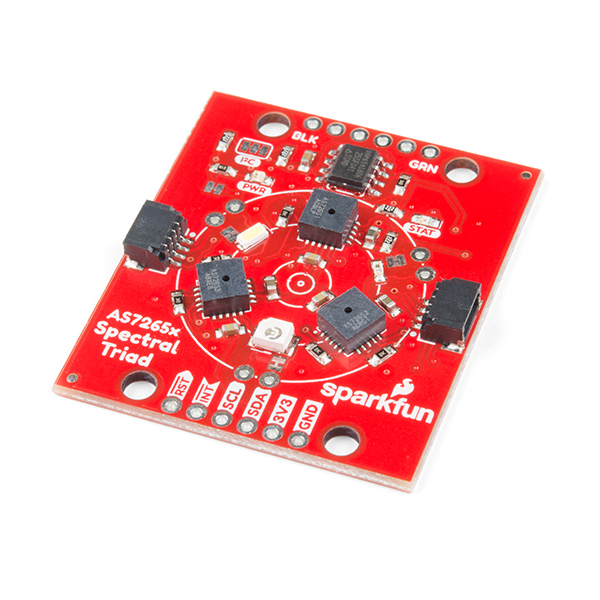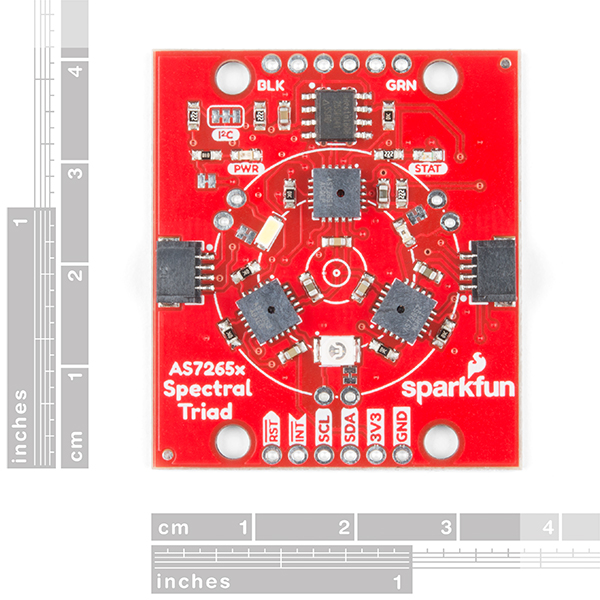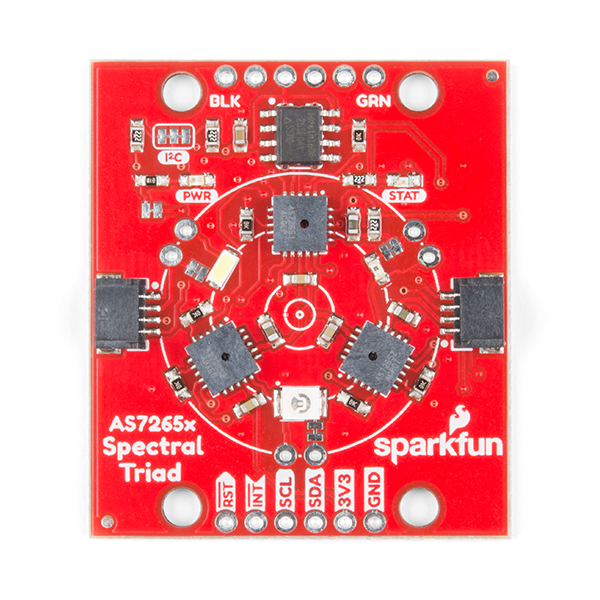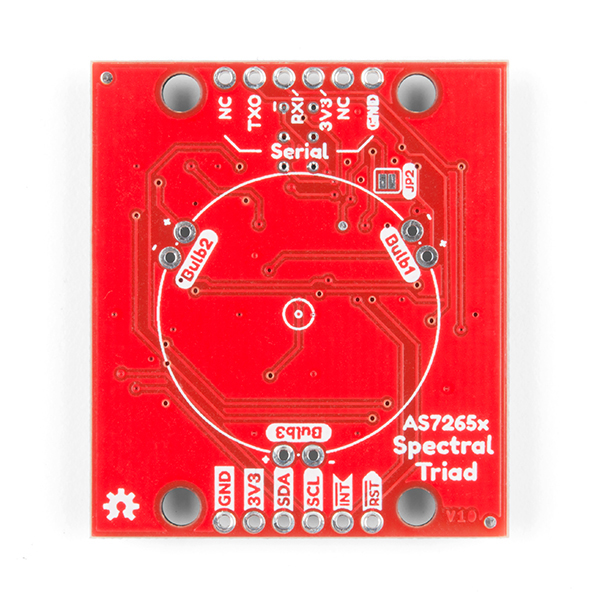SparkFun Triad Spectroscopy Sensor - AS7265x (Qwiic)
The SparkFun Triad Spectroscopy Sensor is a powerful optical inspection sensor also known as a spectrophotometer. Three AS7265x spectral sensors are combined alongside a visible, UV, and IR LEDs to illuminate and test various surfaces for light spectroscopy. The Triad is made up of three sensors; the AS72651, the AS72652, and the AS72653 and can detect the light from 410nm (UV) to 940nm (IR). In addition, 18 individual light frequencies can be measured with precision down to 28.6 nW/cm2 and accuracy of +/-12%. Utilizing our handy Qwiic system, no soldering is required to connect it to the rest of your system. However, we still have broken out 0.1"-spaced pins in case you prefer to use a breadboard.
The SparkFun Triad Spectroscopy Sensor communicates over I2C by default or over 115200bps serial. We've written a fully formed Arduino library to access all the various features include taking readings and illuminating LEDs all over the Qwiic I2C interface. In addition, the Triad can be setup to communicate over serial. The serial interface uses an AT command set.
What can you do with light spectroscopy? It’s an amazing field of study, and the SparkFun Triad brings what used to be prohibitively expensive equipment to the desktop. The AS7265x should not be confused with highly complex photon spectrometers, but the sensor array does give the user the ability to measure and characterize how different materials absorb and reflect 18 different frequencies of light. We've also written a full Arduino library that makes reading and interacting with the Triad simple and easy!
Note: The I2C address of the AS7265x is 0x49 and is hardware defined. A multiplexer/Mux is required to communicate to multiple AS7265x sensors on a single bus. If you need to use more than one AS7265x sensor consider using the Qwiic Mux Breakout.
The SparkFun Qwiic Connect System is an ecosystem of I2C sensors, actuators, shields and cables that make prototyping faster and less prone to error. All Qwiic-enabled boards use a common 1mm pitch, 4-pin JST connector. This reduces the amount of required PCB space, and polarized connections mean you can’t hook it up wrong.
- Selectable interface: I2C or Serial (115200bps)
- 18 frequencies of light sensing from 410nm to 940nm
- 28.6 nW/cm2 per count
- Accuracy of +/-12%
- Integrated 405nm UV, 5700k White, and 875nm IR LEDs
- Software control over each illumination LED as well as current control
- Optional external bulb or illumination control
- Programmed with latest firmware from AMS
- Schematic
- Eagle Files
- Hookup Guide
- Datasheets:
- SparkFun AS7265x Arduino Library - Search for SparkFun Spectral in the the Arduino library manager
- GitHub
SparkFun Triad Spectroscopy Sensor - AS7265x (Qwiic) Product Help and Resources
Spectral Triad (AS7265x) Hookup Guide
November 8, 2018
Learn how to wield the power of 18 channels of UV to NIR spectroscopy with AS72651 (UV), AS72652 (VIS), and AS72653 (NIR) sensors!
Python Examples
For customers interested in using Python instead of Arduino, check out the following GitHub repositories:
Core Skill: Programming
If a board needs code or communicates somehow, you're going to need to know how to program or interface with it. The programming skill is all about communication and code.
Skill Level: Competent - The toolchain for programming is a bit more complex and will examples may not be explicitly provided for you. You will be required to have a fundamental knowledge of programming and be required to provide your own code. You may need to modify existing libraries or code to work with your specific hardware. Sensor and hardware interfaces will be SPI or I2C.
See all skill levels
Core Skill: Electrical Prototyping
If it requires power, you need to know how much, what all the pins do, and how to hook it up. You may need to reference datasheets, schematics, and know the ins and outs of electronics.
Skill Level: Rookie - You may be required to know a bit more about the component, such as orientation, or how to hook it up, in addition to power requirements. You will need to understand polarized components.
See all skill levels
Comments
Looking for answers to technical questions?
We welcome your comments and suggestions below. However, if you are looking for solutions to technical questions please see our Technical Assistance page.
Customer Reviews
4 out of 5
Based on 13 ratings:
2 of 2 found this helpful:
Terrible Data Sheet
No explanation of what to do with calibration data. How do you apply this to the raw data? Very poor explanation on how to use the virtual register. There are very large variations in my raw data. If I collect the data for a copper plate ten times, my standard deviation can be as high as 20,000 (yes, 20 THOUSAND). Did your data show such wide variations?
It makes me believe I got a defective AS7265x board!
Sorry to hear that you are running into issues with this product. I highly suggest that you post on the SparkFun forums providing as many details as possible if you believe that you have received a defective product. Our forum moderators can assist with troubleshooting and confirm if the product is defective: https://forum.sparkfun.com/viewforum.php?f=147&sid=ea4afd8ee56e1a69fa23186739a28b6c
1 of 1 found this helpful:
Awesome sensor!
I was able to make a simple algorithm that could recognize objects based on the light reflected back from the object. It wasn't perfect, but it worked surprisingly well considering I didn't even shield interfering light from the sensor, and I made it work in only an hour or two.
The Triad isn't exactly perfect, but it is very capable and brought spectroscopy to my desk.
Awesome :D
5 of 6 found this helpful:
Wonder if I got a bad sensor !
I concur with the previous review titled "Terrible Data Sheet". I bought this in October and have tested it extensively with various materials and my biggest problem has been how unstable the readings are. Like the previous reviewer said, I can scan the same material 10 times and each time the response will be significantly different. I have tried to eliminate background light by enclosing the triad in a black box, kept thd distance to the sensor about 1.5" consistently and tried to keep all other variables to a minimum. Yet, for a single scan of the same material, if it let it sit there, the values in the visible range keep dropping constantly. I have scanned sunlight (out in the open) and incandescent light and got results that were highly unexpected. I wonder if I have a defective product. I posted a question in the forums weeks ago with pictures and there were zero responses from the moderators.
Easy & Reliable
I'm not great with electronics but this was really easy to use and the Sparkfun resources are really thorough. I've been using this via the I2C protocol with no issues and consistent results.
My only minor comment is that I was not able to find anything about "max intensity" in the documentation. Just required me to tweak my setup for measuring LED spectra a bit.
Fail completely
In my hands and on my systems = useless. Would not load on Teensy 4.1, similar errors on ESP32 Thing Plus. One example produced only zero valued on SF RedBoard Artemis, other examples fail completely. Avoiding this sensor for now.
Great device
Our Science Society (https://scienceandtechnologysociety.org) purchased this detector as a part of NASA's STELLA-Q2 spectrometer designed by Paul Mirel at NASA. They have great instructions for all of their STELLA instruments, and we had ours working within hours. We are presently testing our device, and it appears to be working well. We also have a GitHub repository dedicated to this device(https://github.com/Philliec459/Science-and-Technology-Society-Use-of-NASA-STELLA-Q2-Spectrometer) and software that we are developing to view the data. NASA also has their own viewers. We are now looking to add a GPS module to our STELLA-Q2. Thank you for developing such a good device.
The world is not how it appears
Working with this device teaches you about the limitations of human color perception. The device worked as expected, and can be modified. I really liked the option of working with the UART interface. I wrote a small library in R for obtaining data from the sensor:
https://github.com/pdhoff/SpectralSensorInterface
Great product
I am working on spectroscopy research and this is an ideal piece of electronic kit for the job. It works exactly how the support staff has described. I can see endless science application using the Triad sensor. Take my hat off to people who design the Triad.
18 channel spectrometer ideal for learning to think spectroscopically!
We use these in our STELLA-Q2 instrument: https://landsat.gsfc.nasa.gov/stella/stella-q2/
STEM Simplicity
Bought two units for a STEM-based experiment, building upon the classic Photoelectric Effect (PE) experiment. Students created an RGBAI light source to measure the photoelectric effect and test theories with varying wavelengths to determine the efficiencies of the detector.
A really useful outcome for such a basic physics prac.
Great product, Question about the bulbs though?
Easy to hook up, I was a little skeptical of the quick connectors but their great I've never had a project up and running so fast. I wish it went a little farther into the IR and UV spectrum, but I understand Sparkfun is working with the chips available. I do have a question about the bulbs. Could Sparkfun provide a link to the recommended type of incandescent bulb we are supposed to use on it? I'm a bit hesitant to solder anything to the board because if the bulb burns out I'm stuck with it soldered to the board. I'm really excited to see what kind of difference and incandescent bulb will make on the IR readings. Overall great product for DIY and community based science!





GitHub link
Windows GUI control and data representation program for AS7265x module.
Very nifty! Thank you for posting!
I have completed a project using this spectral triad please find the documents here.
https://digitalcommons.unl.edu/biosysengdiss/111/
This sensor, SparkFun Triad Spectroscopy Sensor - AS7265x (Qwii, is one of the best sensors I have purchased. I could not wait for the back order so I purchased from Amazon. I am hoping that my grand and great grand kids will be interested in the results and how it works. I currently have it connected to one of my WIO Terminals via a MUX board. I can see the results on the display and it also writes the data to the internal Micro SD Card with TABs easily transferred to a spreadsheet. Several items being tested are coffee, hot chocolate and filtered H2O, tap H2O, Well H20 and several brands of purified drinking water. I will try to post my example in the Forum. I also may try just connecting the Triad directly to the Grove I2C connector.
This was supposed to be rated 5 STARS. Not sure what happened.
Hi I'm working with triad sensor and I wish to know which is the maximum values for raw data and for calibrated data too. thanks!
Can you connect multiple triad sensors to the same qwiic shield? I am trying to have one board read values for 2-3 sensors
Hi! I am working on an undergraduate research project, and we're sending a payload up to 10,000 feet to collect data. I was wondering if this sensor can be used on open air, or if it will only work on solids/liquids? Thanks!
I am working on spectroscopy research and its indeed a great product.
I have three questions that I would like it to be addressed: 1- how to calibrate your data and make sure of what I'm getting is right before I start measuring 2- Is there a similar product that covers the MID IR spectral range (15000-2500)nm (20-120)THz 3-If I would like to use this spectrometer as a tranmsission spectrometer can I buy the detectors seperatly?
Hi, I have a problem with this module, since when loading the sensor.takeMeasurements () function; inside a loop with a TFT 2.4 screen it produces a problem since nothing is printed on the screen, just like when I use another screen such as a 128x64 LCD, please someone who can help me!
How to calculate CIElab values from the spectral data from this device?
Unfortunately, this is outside the scope of our support. However, here are some links that looked useful after a Google search:
Have fun doing maths.
This is my version of a python script that plots spectra obtained with this sensor: link
Dear SparkFun Community,
I have written a few simple Python programs that visualize the output of your AS7265x Spectral Triad connected to an Arduino / Teensy. It goes from a simple 2D Plot to a colormapped scatterplot against the measured wavelength
Feel free to test, share, and enhance - still lots of work to be done !
Cheers,
HWR0
SO AMAZING! Thank you. I'll add a link to the library and hardware repos.
Hi Why six channels of each sensor show same values?
Thanks
jagath
Really this is a spectrophotometer. Great job by the way guys.
I was trying to make this exact thing for like 2 years. Unfortunately when I started I knew exactly nothing about electronics. The whole reason I got into electronics was because I had the idea for a cheap photospectrometer to be used in water quality analysis. Damn, o well. Bravo. I was even planning on using these AMS sensors for the first iteration after I saw it on mouser and emailed AMS about it, then once you guys released your sparkx spectral sensors and I saw another cheap and easy spectrophotemeter in the wild I knew Id never catch up. You guys should make a water proof container that allows water analysis, although the light source has to be much bigger.
The applications of this in water chemistry and water quality are huge, although the precision would have to be bumped up. AMS has a couple other options, which of course make it much more complicated. Distributed sensor networks analyzing our water distribution networks, or wastewater, or streams and rivers for water quality would be BIG government contract style money. That market is still there, but im still relatively useless in electronics. Water is my thing.
Thanks! I added a bit to the description to try to capture spectrophotometer.
Welcome to electronics! I'm glad you had a project to get you started. That's how I always learned best. Sorry to hear this product sort of usurped your idea :/ Technology has a way of doing that...
I hope you can find good applications for the Triad. It's a fun, powerful sensor today, and I'm excited to see where the sensor world takes us in the next 2-3 years.
Not at all usurped, I am happy I was pointing in the right direction. Thanks for the response. I am definitely picking one of these up, see if I can try to pull out the the kind of data I had envisioned.
By the way, thanks for a great site, store, and resource. This has always been my favorite site, due to the quality of your products and the range of depth of your tutorials. I recently used the eagle tutorials on here to design my very first PCB, a VNH5019 Motor Driver board. Not too pretty, but it handles 10-20 amps so I am proud. So thank you.
Also, it might be useful to either normalize the readings to the specific emission spectra of the white led or even use an RGB LED and string out the measurements over a time span with each spectrum range being read, or at least saved in memory from the register while that spectrum is being emitted. I know I could do this myself, but I figured other people might want to know that too. The code, as it is, reads all ranges in one function call, from my understanding of it. Maybe ill try to work this out and share it somewhere. I imagine this would do alot for the precision of the readings. This might even allow this sensor to do some readings related to atomic absorption spectroscopy, which is extremely powerful. Thanks again, this has actually inspired me to get back to this idea. Now I just need this sensor to be available again haha.
Hello, I'm student and trying to create the a small device for analysis of water. If you can enter in contact me. We can to exchange ideas and informations about this sensor. Await your return. thanks. My e-mail is skylyne@gmail.com
This is an exciting tool!
But please consider changing the phrase "highly complex mass spectrometers" to "highly complex photon spectrometers". Mass spectrometers use magnetic fields and the velocity of accelerated ions to determine mass. As photons are without mass, photon spectrometers utilize the wavelength to diverge the light based on energy. Sorry to pick at nits.
Thanks!
Absolutely! Thanks for the feedback.